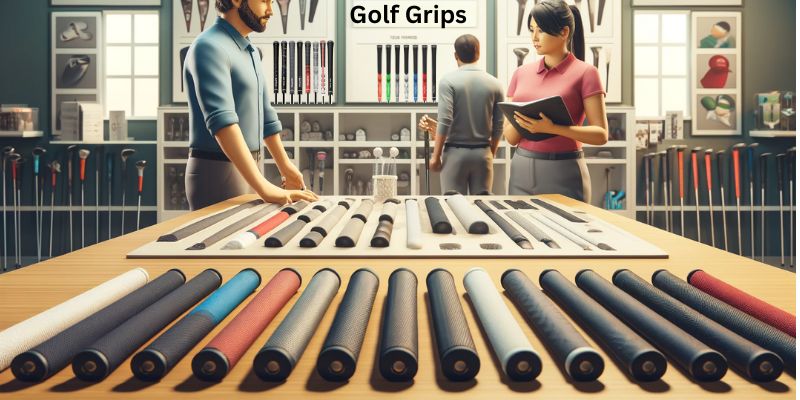Selecting the right golf grip is pivotal for enhancing your game, offering not only a better feel with each swing but also the necessary stability to execute consistent shots.
Golf is a game of precision where even the smallest details, like grips, can have a profound impact on your performance.
Understanding Golf Grip Sizes and Materials
Grip Size: The size of the grip is crucial as it influences how you handle the club during your swing. Incorrectly sized grips can lead to common errors: grips that are too small may cause excessive wrist action, leading to a pulled shot, while grips that are too large can impede your wrist release, often pushing the ball. Golf grips come in several sizes:
- Standard: Best for most hands.
- Midsize: Slightly larger than standard, good for golfers with larger hands or those who prefer a thicker handle.
- Oversized: Even larger than midsize, these are ideal for golfers with very large hands or those who need significant vibration dampening.
- Undersize/Junior: Smaller than standard, perfect for players with smaller hands.
Your grip size should allow your fingers in the upper hand to slightly touch the palm, providing a snug fit that enhances control.
Grip Material: The material of the grip affects both the feel and function under various playing conditions:
- Rubber: The most common material, known for its balance between comfort, tackiness, and durability.
- Corded: These grips have a blend of rubber and woven cord, offering extra traction which is particularly useful in wet conditions or for players with sweaty hands.
- Polyurethane: Known for its soft and tacky feel, polyurethane grips are excellent for shock absorption, beneficial for players with joint pain or those who prefer a gentler grip on their clubs.
Differences Between Driver Grips, Iron Grips, and Putter Grips:
- Driver Grips: Generally designed to offer a good blend of tackiness and comfort, enabling better control for high-speed swings.
- Iron Grips: Similar to driver grips but often come in variations that can enhance feel or feedback, crucial for precise iron play.
- Putter Grips: These vary significantly in shape and size, from traditional narrow designs to modern oversized grips. Putter grips often focus on enhancing feel and reducing wrist action to promote a stable, consistent putting stroke.
When to Replace Your Golf Grips
Golf grips should be replaced regularly to maintain optimal performance.
Indicators that it’s time to replace your grips include noticeable wear and tear, smoothness where there once was texture, hardening of the grip material, and a loss of tackiness.
As a general guideline, replace your grips at least once a year or every 40 rounds, though this might vary depending on frequency of play and storage conditions.
DIY Grip Replacement vs. Professional Service
- DIY Grip Replacement: Replacing your own grips can be economical and allows for customization. It requires some basic tools like a vice, grip solvent, and a sharp knife. There are many online tutorials and kits available to help with the process.
- Professional Service: Opting for professional grip replacement ensures that the grips are installed correctly and aligned perfectly. Golf shops and seasoned professionals can provide this service, offering peace of mind, especially for those less experienced in grip replacement.
Best-Selling Brands: When it comes to high-quality golf grips, several brands consistently receive high marks:
- Golf Pride: Renowned for their wide range of options and innovative designs, particularly popular are their MCC Plus4 and Tour Velvet lines.
- Lamkin: Known for their excellent corded options and the smooth Comfort PLUS series.
- SuperStroke: A leader in putter grips, offering a variety of shapes and sizes to enhance putting performance.
Whether you decide to replace your golf grips yourself or go through a professional, maintaining your grips in top condition is essential.
With the right grips tailored to your needs, you can significantly enhance both your comfort and control, leading to a more enjoyable and successful experience on the golf course.
Why is choosing the right golf grip important?
The right golf grip enhances the feel of each swing and provides the stability needed for consistent shots. It affects your control over the game by influencing swing mechanics and shot outcomes.
How do I choose the correct grip size?
The correct grip size should allow the fingers in your upper hand to barely touch the palm. Standard, midsize, oversized, and undersize grips are available depending on your hand size and personal comfort.
What are the different materials for golf grips and their benefits?
Rubber grips are common and versatile, offering comfort and durability. Corded grips, which combine rubber and cord, provide extra traction and are ideal for wet conditions. Polyurethane grips are soft and tacky, suitable for players with joint pain or those who prefer a softer feel.

